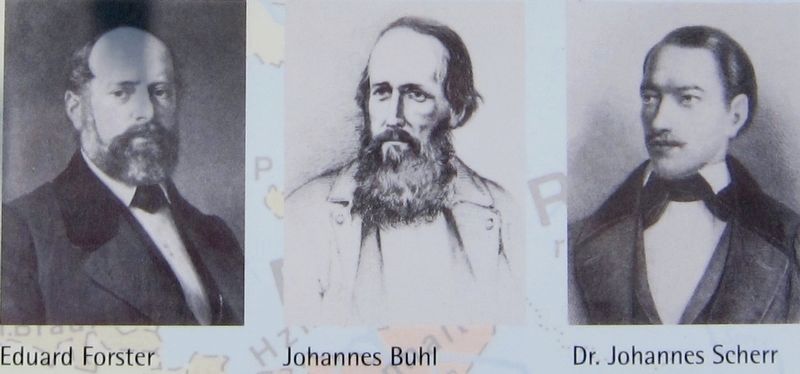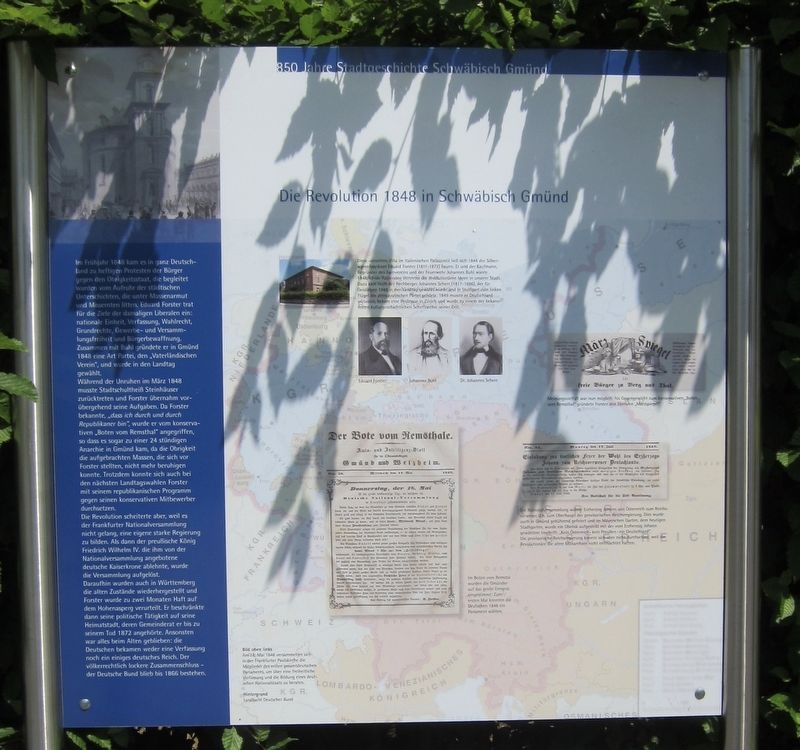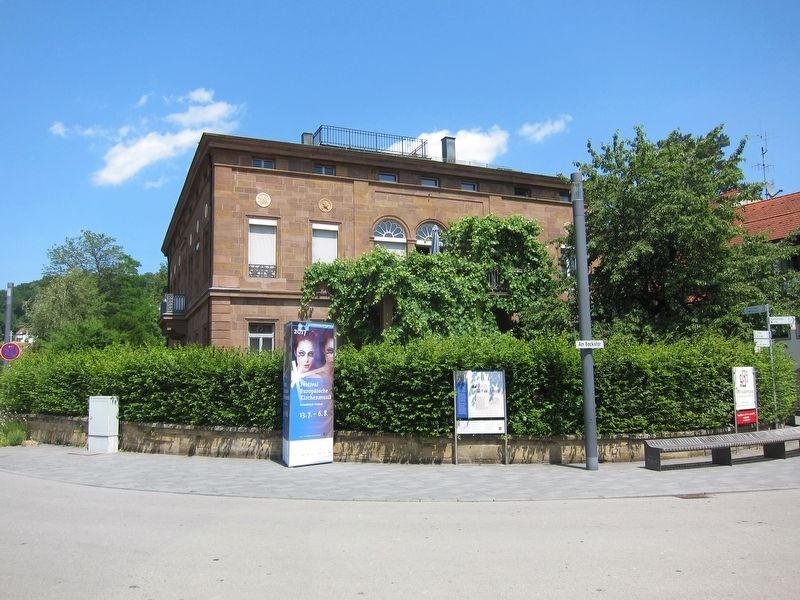Schwäbisch Gmünd in Ostalbkreis, Baden-Württemberg, Germany — Central Europe
Die Revolution 1848 in Schwäbisch Gmünd / The Revolution of 1848 in Schwäbisch Gmünd
850 Jahre Stadtgeschichte in Schwäbisch Gmünd
Inscription.
Während der Unruhen im März 1848 musste Stadtschultheiß Steinhäuser zurücktreten und Forster übernahm vorübergehend seine Aufgaben. Da Forster bekannte, "dass ich durch und durch Republikaner bin", wurde er vom konservativen "Boten vom Remsthal" angegriffen, so dass es sogar zu einer 24 stündigen Anarchie in Gmünd kam, da die Obrigkeit dir aufgebrachten Massen, die sich vor Forster stellten, nicht mehr beruhigen konnte. Trotzdem konnte sich auch bei den nächsten Landtagswahlen Forster mit seinem republikanischen Programm gegen seinen konservativen Mitbewerber durchsetzen.
Die Revolution scheiterte aber, weil es der Frankfurter Nationalversammlung nicht gelang, eine eigene starke Regierung zu bilden. Als dann der preußische König Friedrich Wilhelm IV, die ihm von der Nationalversammlung angebotene deutsche Kaiserkrone ablehnte, wurde dir Versammlung aufgelöst. Daraufhin wurden auch in Württemberg die alten Zustände wiederhergestellt und Forster wurde zu zwei Monaten Haft auf dem Hohenasperg verurteilt. Er beschränkte dann seine politische Tätigkeit auf seine Heimatstadt, deren Gemeinderat er bis zu seinem Tod 1872 angehörte. Ansonsten war alles beim Alten geblieben: die Deutschen bekamen weder eine Verfassung noch ein einiges deutsches Reich. Der völkerrechtlich lockere Zusammenschluss - der Deutsche Bund blieb bis 1866 bestehen.
-
In the spring of 1848 there were violent protests by the citizens against the authoritarian state throughout Germany, accompanied by the turmoil of the urban underclasses suffering from mass poverty and bad harvests. Eduard Forster advocated the goals of what were then the Liberals: national unity, a constitution, fundamental rights, freedom of trade and assembly, and an arming of the people. Together with Buhl he founded in 1848 in Gmünd a kind of party the "Fatherland Association" and was elected to the state parliament.
During the riots in March 1848, town councilor Steinhäuser
had to resign and Forster temporarily took over his duties. Since Forster confessed, "that I am a Republican through and through," he was attacked by the conservative "Messenger from the Remsthal", such that it came even to a 24-hour anarchy in Gmünd, as the authorities could not calm down the enraged crowds that stood in front of Forster. Nevertheless, Forster with his republican program was still able to prevail against his conservative competitor in the next state elections.
The revolution failed, however, because the Frankfurt National Assembly failed to form a strong government. When the Prussian King Friedrich Wilhelm IV refused to accept the German Imperial Crown offered to him by the National Assembly, the Assembly was then dissolved. In Württemberg the old conditions were then restored, and Forster was sentenced to two months imprisonment at the Hohenasperg prison. He then limited his political activity to his hometown, on whose municipal council he sat until his death in 1872. Otherwise, everything remained the same: the Germans got neither a constitution, nor a united German Reich. The internationally loose association - the German Confederation, remained in existence until 1866.
Erected by Schwäbisch Gmünd Stadtarchiv. (Marker Number T11.)
Topics. This historical marker is listed in this topic list: Government & Politics

June 24, 2017
3. Marker detail: Forster, Buhl, Scherr
This noble villa in the Italian palazzo style was built in 1844 by the silver goods manufacturer Eduard Forster (1811-1872) (See Photo 2). He and the merchant, founder of the Turnverein (an association sponsoring cultural and physical activities) and the fire brigade, Johannes Buhl, were the leading representatives of the revolutionary ideas in our city in 1848/49. In addition, there was also Johannes Scherr (1817-1886), who was elected for Geislingen in 1848 in the state legislature and belonged to the left wing of the Democratic Party in Stuttgart. In 1849 he had to leave Germany and got a professorship in Zurich, becoming one of the most famous authors of cultural history of his time.
Location. 48° 47.912′ N, 9° 47.546′ E. Marker is in Schwäbisch Gmünd, Baden-Württemberg, in Ostalbkreis. Marker is at the intersection of Am Bockstor and Pfeifergäßle, on the left when traveling east on Am Bockstor. Touch for map. Marker is in this post office area: Schwäbisch Gmünd BW 73525, Germany. Touch for directions.
Other nearby markers. At least 8 other markers are within walking distance of this marker. Fünfknopfturm / Five-points Tower (about 90 meters away, measured in a direct line); Garten der Partnerstadt Bethlehem (USA) / Garden of the Sister City of Bethlehem (USA) (about 180 meters away); Münsterplatz 12 (approx. 0.3 kilometers away); Glockenturm / Belltower (approx. 0.3 kilometers away); Fuggerei (approx. 0.3 kilometers away); Heimatvertriebene in Schwäbisch Gmünd / German Expellees in Schwäbisch Gmünd (approx. 0.3 kilometers away); Johanniskirche / St. John's Church (approx. 0.3 kilometers away); Marktplatz Nr. 11 / Market Square No. 11 (approx. 0.4 kilometers away). Touch for a list and map of all markers in Schwäbisch Gmünd.
More about this marker. This is the 11th of 21 markers put up by the city archive to commemorate 850 years of history in the city.
Also see . . . . "The German revolutions of 1848–49 (German: Deutsche Revolution 1848/1849), the opening phase of which was also called the March Revolution (German: Märzrevolution), were initially part of the Revolutions of 1848 that broke out in many European countries. They were a series of loosely coordinated protests and rebellions in the states of the German Confederation, including the Austrian Empire. The revolutions, which stressed pan-Germanism, demonstrated popular discontent with the traditional, largely autocratic political structure of the thirty-nine independent states of the Confederation that inherited the German territory of the former Holy Roman Empire....The middle-class elements were committed to liberal principles, while the working class sought radical improvements to their working and living conditions. As the middle class and working class components of the Revolution split, the conservative aristocracy defeated it. Liberals were forced into exile to escape political persecution, where they became known as Forty-Eighters. Many emigrated to the United States, settling from Wisconsin to Texas." (Submitted on August 17, 2018.)
Credits. This page was last revised on December 5, 2022. It was originally submitted on August 16, 2018, by Andrew Ruppenstein of Lamorinda, California. This page has been viewed 163 times since then and 11 times this year. Last updated on November 16, 2022, by Carl Gordon Moore Jr. of North East, Maryland. Photos: 1. submitted on August 16, 2018, by Andrew Ruppenstein of Lamorinda, California. 2, 3. submitted on August 17, 2018, by Andrew Ruppenstein of Lamorinda, California. • Bill Pfingsten was the editor who published this page.

